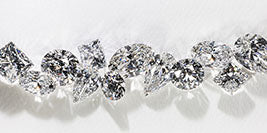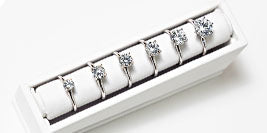There is no denying that sustainability, ethics, and environmental impact are important to many of today’s jewelry consumers—and because of this there is hesitation to purchase a piece that uses earth mined diamonds (EMD). Therefore, much attention has turned to the topic of lab grown diamonds…namely, are they real?
Let us answer that question without hesitation. Yes! Lab grown diamonds are as authentic as earth mined diamonds. MiaDonna’s CEO and Founder, Anna-Mieke Anderson, has a great way of considering the authenticity of lab grown diamonds:
According to the International Gem Society, lab grown diamonds are “chemically, physically, and optically… identical to natural ones. They’re real diamonds with the same crystal structure and beautiful sparkle as natural diamonds.” Additionally, lab grown diamonds showcase the notable distinction of having a Mohs hardness of 10, meaning their durability aligns with earth mined diamonds.
In this blog post, the jewelers at MiaDonna will discuss some other important points for jewelry shoppers to know, including how lab created diamonds are made and where to look for the best lab grown diamonds.
How Are Lab Grown Diamonds Made?
Lab created diamonds are composed of pure carbon, just like mined diamonds. They are created through a variety of technological processes, which mimic the high-pressure natural conditions that ultimately produce EMD.
As such, there are two processes by which lab grown diamonds are created: Chemical Vapor Deposition (CVD) or the High Pressure High Temperature (HPHT) method. Here is an explanation of both:
- Chemical Vapor Deposition (CVD): Through the CVD process, a small diamond seed is placed into a sealed chamber, which is then filled with a carbon-rich gas (methane is commonly used). The inside of the chamber is heated to extremely high temperatures, which ionizes the gas and breaks down the molecules of carbon, resulting in plasma. In turn, this carbon plasma begins to settle on the diamond seed—layer by layer—and results in the formation of a larger diamond crystal. Now, depending on the desired size of the diamond as well as quality metrics, this process can take many weeks to several months to complete.
- High Pressure High Temperature (HPHT): Via the HPHT method, a press is employed that subjects a small diamond seed to temperatures around 1500 degrees Celsius and pressures equaling around five GigaPascals. Then, a metal solvent, usually composed of nickel, cobalt, and iron is also added, which is done to enable the diamond’s growth. The combination of heat and pressure results in the carbon atoms rearranging themselves, which forms a diamond crystal around the seed. Like the CVD method, this process takes time and can vary based on quality and size targets for the stone itself.
As noted, both of these methods mimic how natural diamonds are formed deep within the earth’s mantle—and once formed, possess the same physical, chemical, and optical properties, making them completely indistinguishable to the naked eye.
Once lab grown diamonds are created, they are then cut and polished through the same methods as a natural stone, resulting in a finished gemstone ready to be set in a piece of jewelry.
Are All Lab Grown Diamonds of the Same Quality?
Just like earth mined diamonds, the quality factors of lab grown diamonds can vary and are dependent on the manufacturer’s expertise, the growth technology employed, and the control the manufacturer has over the growth process.
High quality lab created diamonds are more expensive to produce—and therefore garner higher prices in the wholesale and retail markets. Importantly, the best quality lab grown diamonds rival the world’s premier earth mined diamonds.
Taking that into consideration as a lab created diamond jewelry shopper, it’s important to consider the 4 Cs used in evaluating the quality of a stone. Those 4 Cs are carat weight, cut, clarity, and color. We go beyond the 4 Cs, and also consider Community and Certification to be equally important. Every lab grown diamond purchased from MiaDonna gives 10% of profits back to our foundation, The Greener Diamond, which reinvests in diamond mining communities. MiaDonna is also the only lab created diamond retailer to earn BCorp certification, meaning we have unbiased evidence of our commitment to people and the planet.
Are All Lab Grown Diamond Manufacturers Equal?
The simple answer? No. Not all lab created diamond manufacturers follow the same processes, which ultimately impacts the quality of the stone that is produced.
While lab grown diamonds have entered the mainstream marketplace and today compete with EMD companies, there are some manufacturers that have made cutting corners part of their business model in order to make more of a profit while passing along sub-par diamonds to jewelry consumers.
MiaDonna does not subscribe to that model.
We believe that if you want the best earth mined diamonds, you head to Tiffany & Co.
If you want the best lab grown diamonds, you head to MiaDonna & Co.
How is MiaDonna Different in the Lab Grown Diamond Marketplace?
As you consider a lab grown diamond purchase, we invite you to learn a little about MiaDonna’s history.
Our company was started in 2005 by founder, Anna-Mieke Anderson, when she became aware of the origin of her own EMD. Realizing ethical, environmental, and sustainability concerns that surrounded the earth mined diamond market, Anna-Mieke became passionate about finding a diamond option that was conflict-free and socially responsible. As such, she set out to create the world’s most innovative and beautiful diamonds that also valued humanity and the environment—and MiaDonna was born.
Of course, in this quest, MiaDonna was also bombarded and attacked by players in the EMD industry. These parties demanded that MiaDonna market lab grown diamonds as “fake,” “artificial,” and “synthetic”… which, of course, wasn’t and isn’t true.
Therefore, early adopters within the lab grown diamonds industry spent considerable time and resources partnering with and educating influencers at the Federal Trade Commission (FTC) and the International Organization for Standardization (ISO), which is an independent, non-governmental organization that develops and publishes voluntary standards across varied industries, including the diamond industry.
Through deep research, education, testing, and communication, players within the lab created diamond industry were able to change marketing rules and get lab grown diamonds recognized for what they are—chemically, physically, and optically identical to natural diamonds in every way.
Some Other Important Considerations About Lab Created Diamonds
Here are some answers to other questions you may have about these stones:
- Are lab grown diamonds as strong as real diamonds? As noted, both lab grown diamonds and natural diamonds are made of pure carbon. Therefore, they have the same physical properties and strength. No matter the origin, diamonds are the hardest known natural substance on earth and are resistant to abrasion and scratching.
- Are lab grown diamonds GIA-certified? Yes, lab grown diamonds can be certified by the Gemological Institute of America (GIA), which is a highly respected and well-known gem lab that offers grading reports and certifications for all types of diamonds—both natural and lab created. The GIA’s grading standards consider the 4 Cs as well as other details such as polish, symmetry, and fluorescence. The organization’s reputation serves as the trusted standard bearer within the industry.
- Is a synthetic diamond the same as a lab grown diamond? No, they are not the same. Synthetic diamonds are alternatives to natural and lab grown diamonds. Common stones include cubic zirconia and spinel.
- Will a lab created diamond pass a diamond tester? Yes, a lab grown diamond can be tested for authenticity using heat resistance testing, including Thermal Conductivity and Electrical Conductivity. Furthermore, it will pass all necessary tests.
- Why do lab grown diamonds test as moissanite? A bit of background, moissanite is a gemstone that was first discovered in 1893 by a French chemist named Henri Moissan. Mr. Moissan originally mistook the stone to be a diamond as it shared some optical properties; however, the stone also only has a hardness of 9.25 on the Mohs scale. Ultimately, lab grown diamonds should not test as moissanite, but it is possible that if improper testing techniques or equipment are used—or if a gemologist doesn’t have proper expertise—testing results could be misinterpreted, and a stone could be incorrectly identified. As such, it is incredibly important to ensure that lab grown diamonds are tested and graded by the GIA or the International Gemological Institute (IGI).
Are Lab Grown Diamonds Conflict Free?
Finally, let’s get to the important topic of ethics, which is a key concern for many jewelry consumers.
Historically speaking, MiaDonna used to be able to claim that all lab grown diamonds were 100% conflict free as there were only two labs used in diamonds grown in the United States (which our founder partnered with personally).
Today, the market is flooded, and it is hard to determine where a product originates from, the types of labor and regulatory practices that are followed, and if a lab has the necessary environmental credentials.
Our founder, Anna-Mieke, notes, “I spent the last 17 years promoting that all lab grown diamonds were conflict free and eco-friendly. I will never say that again because the truth is, who knows? Like the problem with earth mined diamonds, lab grown diamonds have lost their origin. Retailers are selling diamonds without regard to where they came from or how they got to market.”
This can feel very murky to a shopper seeking to purchase a lab grown diamond engagement ring and can call into question just how lab grown diamonds are made.
At MiaDonna, we stand behind our guarantee that every lab grown diamond is conflict free and ethically sourced. Unlike an earth mined diamond, our lab created diamonds are formulated without negatively harming communities, children, society, or our beautiful planet.
Furthermore, every MiaDonna lab grown diamond ring features a setting that is created utilizing only the finest recycled gold or platinum, which also reduces harmful effects on humanity as well as the earth.
So, how do we prove this claim?
Simple.
Through world-renowned, third-party certifications. Our lab grown diamonds, metals, and business are certified B Corp, Carbon Negative, and Sustainable Choice Standard (SCS). By choosing lab grown diamonds and metals that offer these levels of certification, a consumer can support lab grown diamond manufacturers that place a priority on environmental conservation, sustainable development, ethics, and social responsibility.
Trust MiaDonna for Ethical, Conflict Free Lab Grown Diamonds
As a lab grown diamond jewelry consumer, you want to feel confident and self-assured in your jewelry investment. At MiaDonna we are committed to helping socially responsible consumers purchase lab grown diamond rings that check all the boxes, ensuring you and your loved one values and cherishes your jewelry purchase for years to come.
We invite you to learn more about our lab grown diamonds and all our unique jewelry lines. Reach out to schedule a consultation with one of our personal shoppers today or feel free to peruse our lab grown diamond offerings online.










